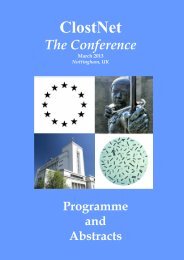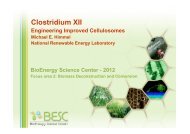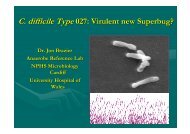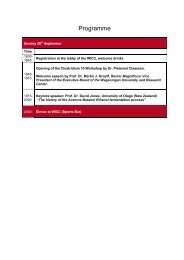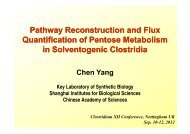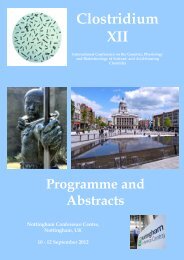abstract book - Clostridia
abstract book - Clostridia
abstract book - Clostridia
- No tags were found...
Create successful ePaper yourself
Turn your PDF publications into a flip-book with our unique Google optimized e-Paper software.
MOLECULAR BASIS OF TOXICITY OF EPSILON TOXINM. R. PopoffBactéries anaérobies et Toxines, Institut Pasteur, 75724 Paris cedex15,FranceEpsilon toxin is produced by Clostridium perfringens type B and D and isresponsible for fatal enterotoxemia in animals, mainly in sheep.Overproliferation of toxigenic C. perfringens in the intestine produces largeamounts of epsilon toxin, which enters the blood stream through theintestinal mucosa, and then diffuses in all organs, preferentiallyaccumulating into the brain and kidneys. Epsilon toxin induces perivascularedema in the brain, and alters neuronal cells leading to the release ofglutamate. Epsilon toxin also promotes extensive edema in the lungs,elevated blood pressure and extensive kidney damages known as "pulpykidney disease". Epsilon toxin is one of the most potent bacterial toxinsexcept the clostridial neurotoxins. Only few culured cell lines such as caninekidney cells (MDCK) or mouse kidney cells (mpkCCD) are sensitive toepsilon toxin. The toxin is secreted as a non-active precursor, which isactivated by proteolytic removing of N- and C-terminal peptides. Epsilontoxin is structurally related to aerolysin, which is a pore forming toxin.Epsilon toxin binds to a specific receptor on target cells, heptamerizes andforms pores through the plasma membrane. But, epsilon toxin recognizes adistinct receptor than that of aerolysin, which has been identified as GPIanchoredproteins, and is much more potent to induce cell death by a yetpoorly understood mechanism. Epsilon toxin causes slightly anion selectivepores leading to a rapid loss of intracellular K + and to a Na + entry, which areaccompanied by a rapid ATP depletion. Epsilon toxin induces apermeabilization of mitochondrial membranes leading to the release ofcytochrome c as well as a mitochondrial-nuclear translocation of apoptosisinducingfactor, which is a caspase-independent cell death factor. However,cell death results from a necrotic process (absence of DNA fragmentation,entry of propidium iodide into the nuclei, no caspase activation) and not fromapoptosis. Epsilon toxin is also highly potent to induce a rapid alteration ofcell monolayer permeability without modifying the intercellular junctions,which is probably the basis for the extensive edema produced in vivo.



